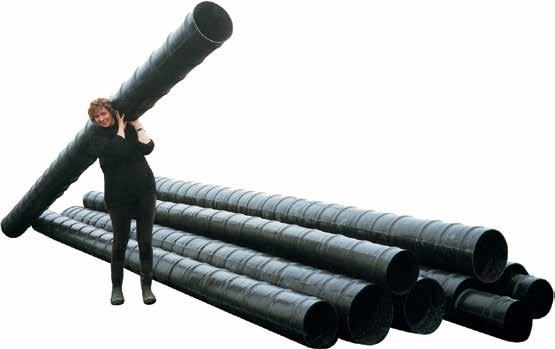TO ALL FARMERS, FOR ALL FARMERS
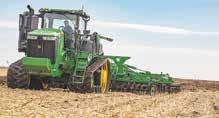


confidence being proposed in the ousted chair and the whole board.
BEEF+LAMB NZ chair Andrew Morrison has been dumped and will stand down at this week’s annual meeting (Thursday March 30).

In what is already looking like a testy outing for B+LNZ has now had extra spice added with a vote of no
Morrison lost his board seat in the southern South Island ward to Geoff Young. Young received 8,777 weighted votes while Morrison received 6,587 votes – a winning margin of 2,190 votes.
Meanwhile, South Otago farmer
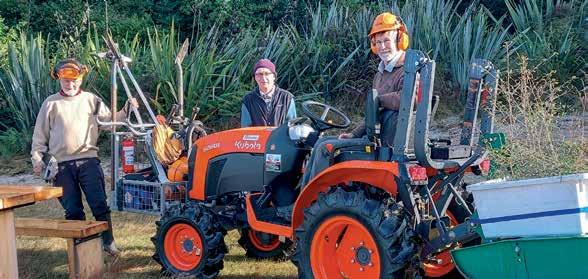
Hugh Gardyne has put up a late motion moving a vote of no confidence in both Morrison as chair (which is now redundant) and entire the board of B+LNZ for their support of He Waka Eke Noa (HWEN).
Gardyne claims B+LNZ has been distracted from its main purpose “to grow the sheep and beef industries and

provide sustainable returns now and for future generations”.
In his no confidence motion, Gardyne claims B+LNZ has been distracted from its mandate in a number of ways, including co-producing the HWEN report, allowing the Government to override this report with their own amendments and then standing
with the Government and signing off on Labour’s Emission Pricing Plan.
Gardyne told Rural News that he’d had confirmation from B+LNZ that the agenda for the AGM has been revised with the deletion of the afternoon farm tour, allowing for more time to consider all the remits and for general business, where his motion will be moved.

“I have been a strong advocate of Beef and Lamb all my farming life, but your patronage of this Labour Government is unprecedented,” Gardyne states in his motion.
“Meetings arranged to inform us on HWEN and discuss the Government’s response have been straight out lectures, with no time or inclination to listen to any opposing solutions. This is a time of reckoning.”
Gardyne accuses B+LNZ of “forsaking its mandate and needing to re-set”.
Ireland’s Minister of Agriculture, Food and Marine was quick to blow the whistle on NZ’s Minister of Agriculture Damien O’Connor during his recent visit to Wellington. However, there was nothing sinister in the whistle blowing. It just so happens that Charlie McConalogue is a sheep farmer and a dog trialist back in Ireland and the gift to him from O’Connor was a very special shepherd’s whistle made from pounamu. McConalogue was one of many Irish ministers of the Crown dispatched from Dublin to all four corners of the world to connect with people who have Irish heritage and join them in celebrating St Patrick’s Day. – See more page 4
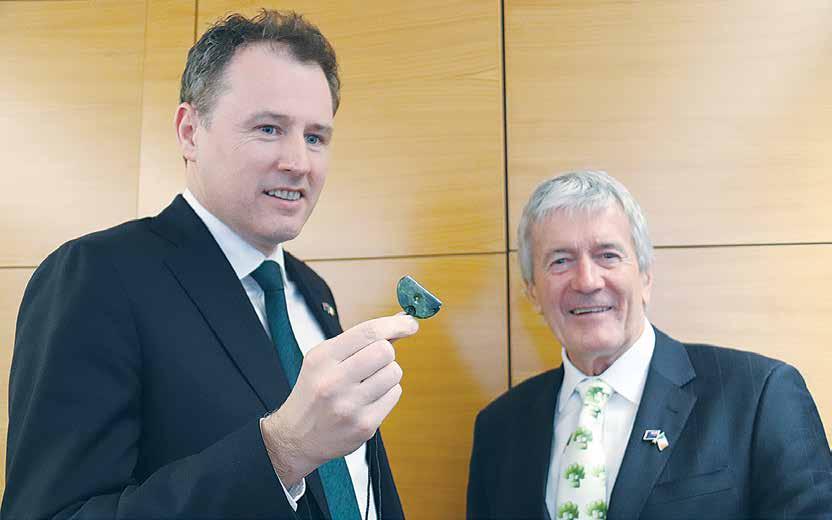
The Ministry for Primary Industries is working hard to help people affected by Cyclone Gabrielle with staff on-the-ground supporting farmers and growers.
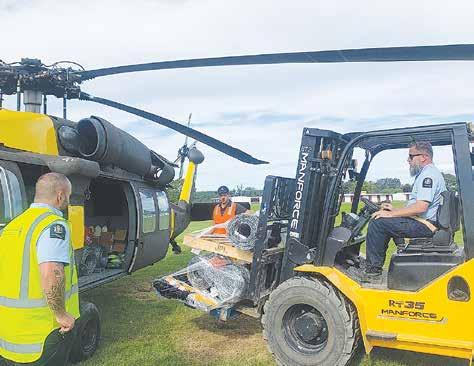
MPI is liaising with Civil Defence, regional response teams, councils, sector groups, whenua Māori entities, and Rural Support Trusts to provide ongoing recovery support.
Coordinating closely with farm supply companies, veterinarians and regional councils – under the umbrella of the National Emergency Management Agency - MPI has coordinated the delivery of supplies such as water reticulation materials, temporary boundary fencing materials, animal health supplies, and veterinary medicines.
To date, more than 35 supply drops have been made in hard-hit areas such as Puketapu, Puketitiri, Pūtōrino, Upper Dartmoor, Lower Waihau Cluster, Tūtira, Esk Valley, Kotemāori and Pātoka.
These are communities that have been extensively damaged or cut off after bridges
Wellbeing help is available for those affected by Cyclone Gabrielle and it’s important people take time to look after themselves, their whanau and community.
Mental health experts say it is normal to feel distressed and to experience symptoms of stress after a traumatic event.
That goes for people involved directly, those who have family and friends involved, those who work in services that are part of the response to the event, and the wider community.
Symptoms of stress include trouble sleeping, feeling tense or irritable, or having repeated thoughts or images of the event. Stress symptoms can be physical such as being jumpy and easily startled, having headaches or pain from tense muscles, and heart pounding.
These kinds of feelings and symptoms are part of our normal reaction to a traumatic
event, and for most people they pass after several days or weeks.
Advice on recovering from traumatic events:
• Spend time in places that feel safe and comfortable as much as possible.
• Tell yourself that how you are feeling is a normal reaction and will pass – it is nothing to be afraid of.
• Reach out to your usual supports – whānau, friends, workmates – sharing how we feel, and offering support to others, is important for recovery.
• Keep to usual routines –mealtimes, bedtime, exercise, and so on.
• Keep active – going to work, doing usual leisure activities, seeing friends, and so on, can distract us from any distressing feelings, and is also helpful.
There is also this advice to help children cope:
• Reassure them that the
MINISTRY FOR BUSINESS, INNOVATION AND EMPLOYMENT
www.mbie.govt.nz
CIVIL DEFENCE PAYMENTS
Visit the Work and Income website or call 0800 400 100
FEED COORDINATION SERVICE
Call 0800 FARMING (0800 327 646)
Register online:
Grazing needed https://arcg.is/0eTPSK0
Grazing available https://arcg.is/OWneD
Feed needed https://arcg.is/11z9mz0
Feed available https://arcg.is/1azj0n
Farmstrong: info@farmstrong.co.nzwww.farmstrong.org.nz, Mental Health Foundation: mentalhealth.org.nz/helplineswww.
Depression.org.nz: www.depression.org. nz, 0800 111 757, text 4202 Rural Support Trusts: 0800 787 254, www.rural-support.org.nz
FirstMate: 0800 237 438. www.firstmate. org.nz
TEXT OR CALL NEED TO TALK? 1737 Access & Choice local provider www. wellbeingsupport.health.nz Healthline: 0800 611 116 Youthline www.youthline.co.nz 0800 376 633 Alcohol Drug Helpline 0800 787 797 Gambling Helpline 0800 654 655 Your health professional. In an emergency call 111
event is over, and they are safe. Encourage them to talk about how they feel about what happened.
• Tell them they can ask questions, and answer these in plain language appropriate to their age – be honest but avoid details of the trauma.
MINISTRY FOR PRIMARY INDUSTRIES www.mpi.govt.nz

0800 00 83 33 info@mpi.govt.nz
DAIRYNZ www.dairynz.co.nz
0800 4 DairyNZ (0800 4 324 7969) info@dairynz.co.nz
BEEF AND LAMB NZ www.beeflambnz.com
0800 BEEFLAMB (0800 233 352) enquiries@beeflambnz.com
• Tell them that feeling upset or afraid is normal, and that telling you how they are feeling will help, that with time they will feel better.
• Be understanding –they may have problems sleeping, tantrums, wet the bed – be patient and reassuring if this happens – again, with support and care it will pass.
• Give your children extra love and attention.
• Remember that children look to their parents to both feel safe and to know how to respond –reassure them, share that you are upset too but that you know you will all be fine together.
• Try to keep to normal routines – mealtimes, bedtimes etc. – allow them to get out and play, to go to the park etc.
FEDERATED FARMERS www.fedfarm.org.nz
0800 327 646
HORTICULTURE NZ www.hortnz.co.nz 04 472 3795 info@hortnz.co.nz
NEW ZEALAND WINE www.nzwine.com 021 192 4924
FOREST OWNERS ASSOCIATION www.nzfoa.org.nz
and roads were washed out in the cyclone.
Animal welfare was an early lead priority in the aftermath of the cyclone, and MPI continues to work closely with animal sector groups, meat processors and farmers to recover from the impact of the cyclone. For example, we are supporting efforts by local communities to get sheep and cattle for slaughter or sale off farms.
MPI and Federated Farmers restarted the national Feed Coordination Service to support farmers recovering from the cyclone.
The service helps match people with grazing or supplementary feed for sale to those who need it.
A total of $51 million has been made available by the Government to farmers, growers, and whenua Māori owners significantly affected by Cyclone Gabrielle.
The funding is to undertake urgent repair work, including fencing, and clearing silt to save trees and vines.
Grant applications closed on March 20, but those in hard to reach areas have until April 3 to apply.
For more information about cyclone recovery go to mpi.govt/cyclonerecovery.
Roads and tracks damaged by Cyclone Gabrielle may mean sheep and cattle being moved or sold will have to be walked longer distances.
Droving and transport can be stressful for stock and it is important to ensure your animals are well prepared and cared for.
Droving
• Prior to mustering, plan a route with adequate opportunities for rest and access to water.
• Consider conditions such as uneven surfaces, river crossings and steep terrain.
• If the temperature is high, try to move animals during cooler parts of the day.
• Muster at a pace which matches the slowest animals in the mob. Take it slow and steady.
• Stock must be fit enough to walk.
• At the end of each day, animals need time to settle down and find shelter before it gets dark.
If in doubt, consult your veterinarian about the suitability of your animals for droving.
• Empty out stock in a grazed area or holding yard prior to transport for at least four hours.
• Do not limit access to water.
• Hay or baleage can be provided.
• Supplement lactating cows with calcium and magnesium on the day of transport.
• Animals must only be transported when they are fit enough to withstand the entire journey without suffering unnecessary or unreasonable pain or distress.
• Consult your veterinarian about the suitability of your animals for transport.
MPI is supporting Hawke’s Bay farmers with limited road access to coordinate the movement of livestock.
Further information and local fact sheets can be found here: www.mpi.govt.nz/ CycloneGabrielleRecovery
BEEF + LAMB New Zealand says it is open to providing farmers with “additional comfort” around how it balances the needs of all levy payers.
B+LNZ chief executive Sam McIvor told Rural News that there is always room to improve policy, advocacy or process.
His comments come as a contentious remit, seeking to prioritise advocacy work for the sheep and beef sector over dairy farmers, is voted at B+LNZ’s annual meeting this week.
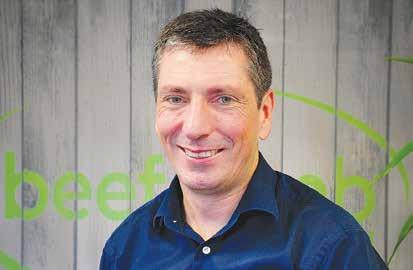
The remit is causing angst among dairy farmers, who collectively pay around 20% of B+LNZ’s overall levy income.
On average, dairy farmers pay around $400 per farm to B+LNZ annually on cull cows and other animals they send to slaughter at $5.20 per head.
B+LNZ is telling farmers that its advocacy work strives to achieve the best possible outcomes for sheep, beef, and dairy farmers’ beef enterprises.
“In our view, the pastoral sector has a stronger voice when it’s united. In most cases the interests of all pasto-
ral farmers are aligned,” says McIvor.
“Good examples include winter grazing regulations and more recently RMA reform.”
But he admits that there are times when the positions of the dairy sector and B+LNZ differ to a greater or lesser degree.

“When this happens, B+LNZ does not change its positions for the sake of seeking alignment – we agree to differ. Examples of this include PC1 in Waikato and the setting of methane targets in the Zero Carbon Bill,” McIvor says.
“However, we also note there is always room to improve policy, advocacy or process, so we would be open to further work to provide farmers with additional comfort around how we balance the needs of all our levy payers.”
The remit, filed by chairman of Farmers 4 Positive Change and Katikati sheep and beef farmer Rick Burke, wants B+LNZ advocacy position “taken from a sheep and beef sector standpoint”.
During any advocacy negotiations, if there’s perceived or actual conflict
between the two sectors, the remit wants B+LNZ to declare the conflict.
McIvor says it is aware of concerns among “a small number” of sheep and beef farmers about B+LNZ collecting levies from both sheep and beef farmers and dairy farmers.
“The consistent request from our farmers has been to work more closely with the dairy industry due to common issues,” he explains. “All of these farmers live and work in rural areas and have emphasised that they want to see vibrant farming communities for everyone.”
McIvor says New Zealand’s dairy, sheep and beef industries are closely linked, with a significant proportion of New Zealand’s beef exports coming from dairy beef.
“Many sheep and beef farmers view dairy support – including where raising dairy heifers or grazing dairy cows – as a critical part of their business.”
Even if the remit is passed at this week’s AGM in New Plymouth, McIvor says there won’t be any changes to the beef levies dairy farmers pay as a result of the remit.
He notes that remits are not binding but the B+LNZ board must “respond and act accordingly”.
THERE ARE signs that the Chinese economy is rebounding after Covid19 but dairy farmers may need to wait a little longer to reap full benefits from their biggest market.
Westpac senior agri economist Nathan Penny notes that after growing at a paltry 3.5% over 2022, the

Chinese economy should grow at around 6% over 2023.
“Already, we are seeing this impact in some of our export markets,” says Penny.
“Sheepmeat markets have firmed and mutton and lamb flat prices, products popular in China, have jumped over the past few weeks. Similarly, export log prices have picked up, surging by around 20% since the
start of the year.”
In contrast, global dairy prices have largely yet to budge.
Penny points out that since the start of the year, overall prices have slid by around 5%, while whole milk powder prices have fallen by around 1%. The latest Global Dairy Trade (GDT) auction saw whole milk powder prices down 1.5% to US$3228/ metric tonne.
“The exception to this overall weakness is butter prices, which have firmed by around 3% so far this year despite dropping in last week’s GDT auction,” he says.
“And this is the first sign that dairy demand is improving as Chinese consumers enjoy their newly found freedoms and head back out to restaurants, cafes and bakeries, places that use large quantities of butter.”


IRELAND’S MINISTER of Agriculture, Food and Marine blew the whistle just moments after he and NZ’s Minister of Agriculture Damien O’Connor concluded their formal talks in Wellington.
However, there was nothing sinister in the whistle blowing. It just so happens that Minister Charlie McConalogue is a a sheep farmer and dog trialist and the gift to him from O’Connor was a very special shepherd’s whistle made from pounamu – NZ greenstone.
McConalogue hails from farming stock in county Donegal and was able to quickly prove
within the hallowed halls of Parliament that he has mustering skills.
McConalogue was one of many Crown Ministers dispatched from Dublin to all four corners of the
world to connect with people who have Irish heritage and join them in celebrating St Patrick’s Day.
One of the main duties of Charlie McCo-
IN THE past, Irish farmers – along with those from England and France – have been less than enthusiastic about NZ agricultural exports to Europe.
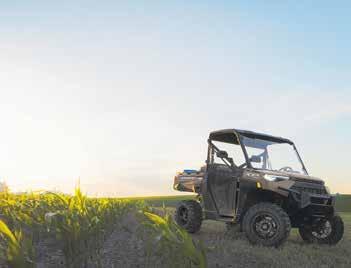
However, with the advent of the EU/NZ FTA, which is nearing ratification, Charlie McConalogue sees this changing.
He says everyone is in a different space globally because demand for food is increasing as the as world’s population grows.
McConalogue says, as a consequence, a lot more is being asked of the land and its ability to contribute to food production. On top of this, he says the land is having to deal with
issues around sequestration and carbon capture and address the challenge of biodiversity.
“We are asking a lot of the land and the challenge in the years ahead is how we can continue to be more productive, and in a way that is more sustainable and with a lower footprint,” he explains. “I see lot of opportunity for our two countries to collaborate as we have shared objectives in terms of meeting that challenge.”
McConalogue says there has always been great friendship between Ireland and NZ and in the past some straight competition. But he believes now is the time to exploit
nalogue was to officially open the Irish Embassy in Wellington, which has been operating – like the NZ Embassy in Dublin –for the past four years. He also met Irish people
the great opportunities for partnerships in many areas.
He says both countries, along with the EU, share similar values and this includes the commonality between Māori and Irish in particular.
“My take home message is that I have come away with is that we have the ability to build on the relationships that have been growing over the years and to do more as partners as we both have pasture based systems,” he told Rural News

“And also the fact that agriculture is a significant part of both of our economies and we have the same connections and affiliation to the land.”
in Auckland, Wellington and Christchurch. McConalogue says he first came to NZ in his early twenties as a backpacker and spent time touring the South Island.
“I knew what a lovely country it was, so looking forward to coming back,” he told Rural News
As well as connecting with Irish people in NZ, McConalogue and his advisors spent time looking at farms in the North Island. He also visited Lincoln University to meet with staff, as well as AgResearch and Silver Fern Farms, who are all working on a number of joint venture projects with Irish scientists.
McConalogue and O’Connor met last year in Ireland and there is a clear friendship and working relationship exists between the pair, with both praising each other’s work in the areas of agriculture and trade. McConalogue says when O’Connor was in Ireland the pair signed a $14 million agreement to jointly collaborate on research projects.
“I wanted to come to NZ to see face-to-face the similarities of the two countries, and of course, having met Damien when he was in Ireland a year ago, we had a number of meetings,” he says. “It was great being here this week to build on that.”

FONTERRA FARMERS are picking up the tab of about 30 fellow shareholders forced to dry off due to damage caused by Cyclone Gabrielle.
Some Hawke’s Bay farms remain inaccessible by milk tankers, bringing their 2022-23 season to an end months earlier than normal.
The co-operative has agreed to pay these farmers for loss of income under its ‘force majeure’ terms, based on the average of the past three year’s milk production.
Fonterra Co-operative Council chairman John Stevenson told Rural News that he is really proud of how the co-op has supported affected members. “Fonterra has covered farmers’ milk that was unable to be picked up, including to continue to support those who have had to dry off due to no tanker access,” he says. “This is a unique benefit of being part of the co-operative.”
Stevenson, who was in Napier last week, met some of the affected farmers.
“I was blown away by the resilience shown by farmers I met who had been cut off by the storm. Some have significant infrastructure damage to farms.
“Many co-op members, including councillors, have also provided support to their fellow co-op members, both during the weather events themselves and afterwards, including by sending generators, feed, and making donations of rewards dollars via Fonterra Farm Source.
“I have not heard from one farmer shareholder who does not support the co-op covering for lost milk.” – Sudesh Kissun

WINNING THE East Coast FMG Young Farmer of the Year title hasn’t sunk in for Patoka farmer Patrick Crawshaw.

Attending the awards ceremony in Dannevirke was a “surreal feeling” for the 29-year old, who hadn’t been into town since the cyclone cut off his only access route late last month.
A day after winning the title, Crawshaw was back in Patoka working on the farm and helping the community.
“Describing the win is hard because for so many ways it hasn’t sunk in,” Crawshaw told Rural News
“Following the awards ceremony on Saturday, I was exhausted and really just caught up on rest, but then the follow-

ing day it was straight back to reality and I had to get back home to Patoka to continue on with farm jobs and support the community getting stock out across the river, which had been a few weeks in the pipeline getting sorted.”
He hopes to find some time in the next few days to reflect on what has been and ultimately what is to come. Crawshaw says the win has made the community proud.
“I am really humbled by the offers of congratulations and admiration that I have received but I just wanted to go and do my best and find a distraction from our immediate challenges.”
Crawshaw and wife Isabelle farm 250ha of pasture for prime beef and lamb production for the US market.
About 27ha of land has
been retired for forestry, carbon and biodiversity.
They purchased the property in 2018: for over three years it was Beef +
Like many other farmers in the region, the Crawshaws were impacted by Cyclone
our belongings”.
Crawshaw says infrastructural damage and access is their biggest challenge to overcome. Water systems and boundary fences of the farm have been restored.
“We have lost a bit of grazeable land with slip scarring but thankfully a spell of sunshine has helped heal what was perceived as non-productive.”
The current phase of recovery has been focusing on animal husbandry.

He says then will come a concentrated effort will go towards resuming control within the farm gate.
“The lack of control within the farm gate is a serious issue as we typically would be setting up reserves for winter in March,” he explains. “It is a long journey ahead and will take a number of years before pre Gabrielle
productivity is restored.” Crawshaw and other farmers in the region are getting support including a $10,000 grant from the Ministry for Primary Industries.
He says they have benefited from the private sector donation of fuel, generators, food, dog food and fencing equipment.
“As a community we received a lot of support from private companies and donations in the first couple of weeks for basic supplies and now we are starting to see support come through with initiatives like donated fence posts.
“The farming gear donations will be extremely valuable to us and we are hoping that there will be some more support coming from the Government financially for recovery on farm.”
FARMING IS A 24/7 JOB, SO TO HAVE THAT SUPPORT IS ESSENTIAL
THE MYCOPLASMA
bovis eradication programme has reached a big milestone with the depopulation of all confirmed infected properties in the stubborn pocket of infection in mid-Canterbury.
The Wakanui area, containing ANZCO Food’s big Five Star Beef feedlot, had been under a Controlled Area Notice since October but all eight cattle properties in the area have since been cleared of stock and disinfected.
The Ministry for Primary Industries (MPI) says stringent testing and monitoring for infection in cattle during the past six months in the ‘at-risk’ area has not identified the presence of M. bovis. The Controlled Area put in place in October, which prohibited cattle movement in or out, has now been lifted.
Mycoplasma bovis programme director Simon Andrew says Wakanui farmers can again farm free of M. bovis.
“These farmers have had to farm with M. bovis in their region since December 2017 when the first M. bovis farm in
Ashburton was discovered.”
The feedlot was an early infected property but had been left for depopulation because of its unique place in New Zealand agriculture. Taking beef animals from all over the country and sending them only for slaughter, it was considered a high risk for reinfection while M. bovis remained elsewhere, but a low risk for infecting others.
By May last year it was the only Confirmed Infected property left in the country, until infections began reappearing in the Wakanui area. That raised speculation of airborne transmission and led to the declaration of the Controlled
There was a tendency for people to be “a bit stand-offish” towards those who were caught up in it, in the suspicion that they may represent a disease risk.
“It’s quite hard to change peoples’ perception.”
He says that only added to the frustration and stress on those affected.
Dondertman notes the full eradication
Area, although a review by epidemiologist Dr John Happold was unable to identify the infection
programme is only at the half-way mark of what was always expected to be a tenyear process.
“Fingers crossed we don’t actually have any infected cows at the moment.”
He had spoken to a couple of farmers recently who’ve been a bit surprised that they’ve been tested again but farmers need to understand why the testing will continue.
“We’ve spent a lot of money and a lot of people’s time and heartache to get rid of the disease. We don’t want it to potentially flare up,” he added.
route. In a statement to Rural News, ANZCO Foods says it has worked
very closely with MPI, followed all MPI’s advice, and complied with all MPI’s biosecurity require-
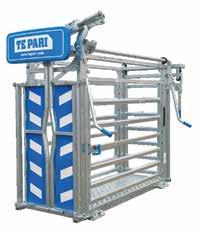
ments as part of depopulating the feedlot in December 2022, and the cleaning and disinfecting process, which concluded in March.
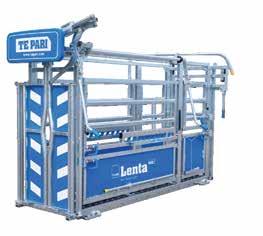

ANZCO says repopulation began in the week beginning March 20, “in conjunction with advice from MPI and on the basis of their assurance and confidence that the eradication programme is on track”.
Andrew says M. bovis had not been found outside of Canterbury in more than two years.
“We will continue to monitor the area closely and are taking a cautious
approach, so we can act quickly should there be reinfection in the wider national herd.”
The programme’s national background surveillance screening will continue for a further four years, to quickly detect any last remaining infected farms and gather the necessary evidence to declare freedom from M. bovis in New Zealand.
“Keeping NAIT records up to date is crucial to our ability to monitor risk and track down potentially infected animals before M. bovis spreads to other farms,” Andrew says.
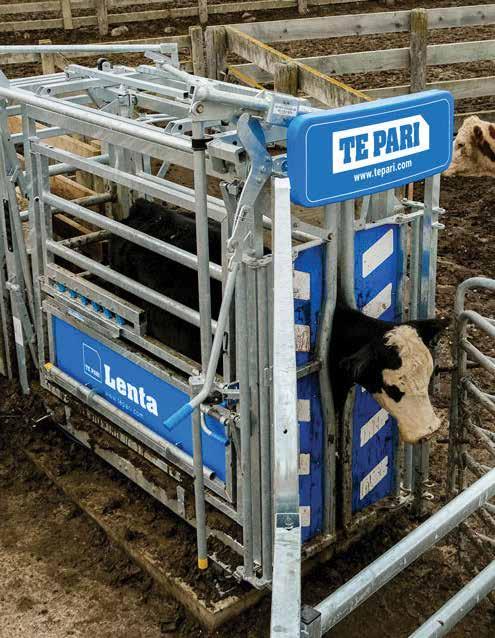
“Keeping NAIT records up to date is crucial to our ability to monitor risk and track down potentially infected animals before M. bovis spreads to other farms.”
A CASE of atypical bovine spongiform encephalopathy (BSE) in Brazil has resulted in temporary export suspensions from that country – as well as renewed international calls for increased transparency.
The case in question was reported in a nine-year-old bull in the state of Para on February 22. Atypical BSE differs from classical BSE in that it is a rare, spontaneous genetic mutation and
NZ’s senior manager of international trade Frances Duignan says the organisation had been unaware of this information.
“Rapid reporting is an expectation we have of all WOAH members, because it is key to minimising spread,” she told Rural News
Nonetheless, Duignan expressed “confidence” in the WOAH’s ability to resolve reporting issues with member nations.
In November 2021, after two reported BSE
nese beef imports and that in previous occasions of suspensions, Brazilian export numbers quickly returned to normal once suspensions lifted.
almost exclusively found in older cattle. Classic BSE is caused by feeds contaminated by meat and bones from animals infected with classic or atypical BSE.
On February 23, Brazil voluntarily shut down beef exports to China, with several other countries also suspending Brazilian imports during this period.
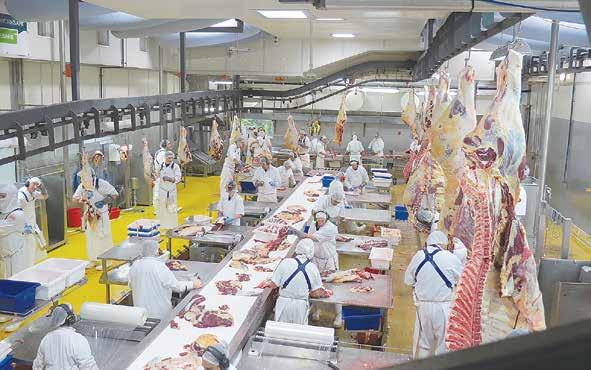
That seemed a speedy response, until a look at the World Organization for Animal Health (WOAH) event submission form revealed that the start of the event was listed as January the 18th – 35 days before the case was reported. MPI says a potential New Zealand case of a WOAH exoticlisted disease means we would be obliged to report it within 24 hours.
This is not the first time Brazil has been late in reporting BSE cases. Previous reported instances in 2021, 2019, 2014 and 2012 have also shown late reporting of atypical BSE confirmations, with one instance in 2012 taking over two years to report.
Despite engaging with the Brazilian beef industry through several industry groups, Beef+Lamb
cases in Brazil that year, three US Senators introduced a bill aiming to suspend beef imports from Brazil until a review of Brazilian beef’s impact on food safety could be conducted. The bill did not pass, but just days before last month’s report from Brazil they announced an attempt to re-introduce the bill into Congress.
Brazil has the world’s largest commercial cattle herd (22.2% of global cattle numbers) and is the world’s second largest beef exporter (15.4%). Because atypical BSE is rare, unpredictable and predominantly found in older cattle, Brazilian beef is considered “negligible risk” by the WOAH.
Brazil’s Minister for Agriculture Carlos Favaro says they aim to resume exports of beef products to China by late March, in time for President da Silva’s state visit. This in comparison to 2021 when exports did not resume for three months after reporting date of a BSE infection.
Both MPI and B+LNZ were unable to comment on matters regarding Brazil-China relations.
Duignan says New Zealand accounts for approximately 5% of Chi-
You can say for sure, when it comes to quality and performance, Boehringer Ingelheim cattle products will keep your stock at their very best. Equally, this cookware by Zwilling is known

outperform expectations and designed to handle any recipe for success.

The case in question was reported in a nine-year-old bull in the state of Para on February 22.


A CANDIDATE for the upcoming Silver Fern Farms Co-operative
board elections says the co-op is going to need continued strong governance to handle the challenges facing farmers.
Will Clarke and his
wife Stacey farm near Clinton in South Otago. He’s one of four candidates vying for two board seats. The other candidates are Simon Davies,

Anna Nelson and Rodney Booth. Voting packs go out to shareholders this week.
The Clarkes farm 950ha and milk about

1500 cows. It’s a self-contained property and the couple rear all their own young stock and beef calves.
Clarke started out as
a chartered accountant working for Deloitte as a senior analyst in Dunedin, providing professional services and advice on a range of issues from taxation to capital allocation and strategic planning. His family has been in Clinton since the 1890s and he’s been back on the farm for 10 years. As a relatively young farmer, Clarke believes he’ll bring diversity to the board, complementing the skills that are already there.
“I think the future for red meat production is very positive and there’s loads of opportunity out there in the market,” he says.
“The financial expertise on the board and the experience I have across a wide range of business will allow me to make a strong and immediate contribution to the SFF board.”
As a hands-on farmer, Clarke says that he understands threats to farming businesses, including factors outside farmers’ control.
“Rampant inflation
For more information
0800 171 825
in farm costs, combined with low prices and high interest rates make it difficult for our sheep and beef farms to remain profitable,” he told Rural News. “It’s essential we navigate through government and climate change regulations to ward off the onslaught of land-use change to forestry so that our farms are there for the next generation.”
Clarke was part of the Silver Fern Farms emerging director group 2021-22, Farmlands Cooperative Society board observer 2020-21 and has been a Clutha Development Group board member since 2018. He also served as a trustee of the Clutha Foundation since 2021 and has been part of various community organisations and clubs.
In 2022, Clarke won the Institute of Directors Otago/Southland Emerging Director award and completed the Fonterra Governance Development Programme and the Core governance and extension course.
and up to five days prefarrowing.
ALMOST TWO thirds of pork consumed in New Zealand comes from countries that fail – and are not required – to meet our animal welfare standards.
That’s according to NZ Pork chief executive Brent Kleiss, who calls the differences between imported and NZ pork “clear”.
“Based on the countries supplying about 98% of imported pork last year, all of the European countries except Sweden, plus Canada, routinely confine sows in gestation stalls for the first four weeks of pregnancy, while the USA can confine sows for the entire pregnancy.”
Gestation stalls were banned in New Zealand in 2015.
More than 50,000 metric tonnes (t) of overseas pork was imported into New Zealand in 2022, with the highest volume coming from Spain at 11,450t, a big increase on the 6,328t imported during 2021.
Runners up include Germany with 11,158t, Poland with 5,267t, Canada at 4,541t, Finland with 4,407t and the USA at 3,867t.
Kleiss said that New Zealand’s pork sector has more stringent welfare and environmental standards and enforcement regimes than most
other countries, with only Sweden – accounting for 2,976t in 2022 – having higher standards of pig welfare than New Zealand in some areas such as higher minimum spaces and more access to bedding materials.
Australia, which exported 2,807t of pork to New Zealand in 2022, comes close to Kiwi standards, with most Austra-
lian pig farmers not using gestation stalls. However, this is by voluntary agreement rather than the legislated requirement it is in New Zealand.
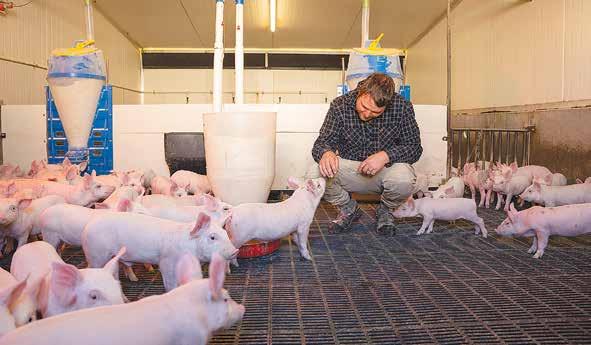
Piglets are routinely castrated in Europe, the USA and Canada, with Spain, Poland and the USA not using pain relief.
In Australia, castration without pain relief is still permitted if piglets
are less than three weeks old. New Zealand farmers do not castrate piglets at all.
EU countries and the USA also have no limit on the amount of time a sow may be confined in a farrowing crate, either before or after giving birth. Canada allows up to six weeks.
New Zealand has minimum standards and regulations placing limits on the length of confinement in a crate and describes the spatial requirements of a farrowing crate.
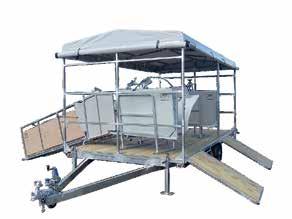

Sows are only housed in farrowing systems when it is time for them to give birth and care for their piglets, spending a maximum of 28 days in conventional indoor systems after giving birth
A spokesperson for the Ministry of Trade, Sharon Lundy, told Rural News that while under current FTA’s a ban on imported pork that fails to meet New Zealand standards could not be implemented, the EU and UK FTA’s were endeavouring to not weaken or reduce protections afforded to farmed animals welfare and promoting positive animal welfare practices.
However, there was a caveat that this was done without “materially affecting trade or invest-

ment between parties” –a very vague statement open to interpretation.
Kleiss said the EU was reviewing animal welfare standards to eventually bring them into line with New Zealand, but this would likely not be the case for Canada or the USA anytime soon.
“We urge Kiwis to back New Zealand pig farmers and always look for a 100% NZ Pork label so they know they’re getting a cut above the rest. We believe it’s time that all imported pork is required to meet our high standards.”
The kiwisbackingfamers.nz campaign highlights the overwhelming wave of unworkable and flawed policies and proposals affecting sheep and beef farmers across the country.

The campaign allows Kiwis to show their support for sheep and beef farmers and send their views directly to the Government.
Ask your local communities and your urban mates to get in behind the campaign.
“Based on the countries supplying about 98% of imported pork last year, all of the European countries except Sweden, plus Canada, routinely confine sows in gestation stalls for the first four weeks of pregnancy, while the USA can confine sows for the entire pregnancy.”
Beef + Lamb New Zealand and 50 Shades of Green are running a campaign raising awareness about the crippling Government policies threatening the future of sheep and beef farms across the country.
A LEADING Australian banker says commentators that keep pillorying farmers for not doing enough for the environment have a negative effect.
Lachlan Monsborough, head of sustainable business for Rabobank, believes such negative comments tend to put farmers off and they will remain on the outer, instead of gaining more knowledge and information and being part of the solution on environmental matters.
Monsborough was one of the keynote speakers at the recent Agricultural Climate Change Conference held in Wellington, which attracted more than 300 participants. The focus of his presentation was on aligning

climate ambitions with realities.
Speaking to Rural News at the event, Monsborough noted that farmers are extremely pragmatic people and respond positively when presented with unassailable facts. He added that everyone is a part of environmental matters and
finding ways of mitigating emissions and adapting to climate change.
“Farmers want to do things, they don’t want to sit back waiting,” Monsborough says. “Once they understand the issues and the options, then a lot of the emotion that has driven the debate in the past comes away.”
He says, in terms of climate change, governments, industry bodies and markets have invested heavily in getting the message out. Monsborough says it is up to farmers to invest and collaborate to get the right answers. “We see our role as bankers to challenge their investment decisions and make sure it’s the right choice. As part of that, we provide information and networks to support those decisions so that farmers have the products to fit those decisions.”
Monsborough acknowledges that there is a lot of misinformation out in the public arena, especially on social media.
He says Rabobank is trying to counter this by sourcing the best objective minds in the business to give their clients’
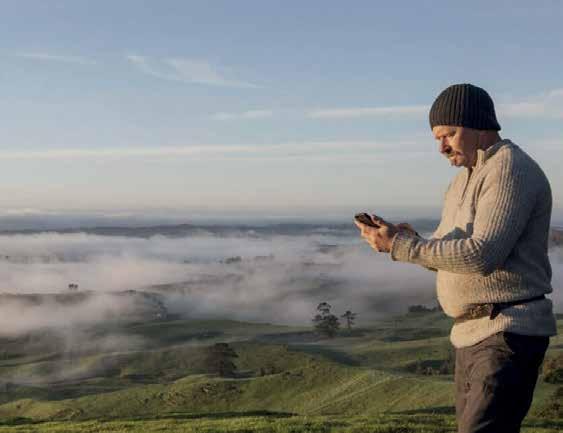
FARMAX is an awardwinning farm modelling and decision support tool developed for pastoral farmers in New Zealand. The tool allows you to build a model of your own unique farm system and use it to record actual farm performance data, forecast future expectations and investigate unlimited scenarios for potential changes to your farm system.
A popular scenario of late has been in relation to greenhouse gas emissions, as all farmers are required to have a written plan to measure and manage their GHG emissions by the end of 2024.
There are a wide range of opportunities to alter the GHG profile and production, including:
• Reducing the total dry matter consumed on farm
• Improving the efficiency of pasture and crop production
• Matching feed demand
with pasture growth and utilisation
• Improving the management of livestock effluent
• Capturing and storing carbon
FARMAX provides confidence for farmers and rural professionals alike when it comes to making any farm plan, as you can model different scenarios to the farming system before making the changes.
“It really comes back to assessing your options and that’s where FARMAX can come in – you model your farm, play around with it, see what you could do and that will give you the implications both for greenhouse gases and for farm profitability.”
Phil Journeaux, AgFirst Waikato.However, FARMAX can be used for much more than just a GHG plan.
These are some of the reasons why farmers love FARMAX:
the best information.
“For example, in Australia we are trialling our 60 sessions in the country with Professor Richard Eckard of Melbourne University –who is a highly regarded expert in sustainable agriculture.”
He says Eckard’s role is teaching ‘carbon 101’: how the emissions are generated on farm, what the sequestration opportunities are, and helping farmers to know their actual number as a farming business.
Monsborough says it’s not widely recognised that farming is and always has been constantly evolving.
“This is in a number of areas, including efficiency and dealing with the environment, but ultimately it’s about meeting societal and other expectations.”
THE FIRST shipment of the 2023 New Zealand kiwifruit season recently departed the Port of Tauranga, carrying around 2,500 tonnes (more than 600,000 trays) of Zespri SunGold Kiwifruit to customers in Japan.
The ship is expected to reach Tokyo in early April before sailing onto Kobe. It is the first of 53 charter vessels Zespri will use this season to deliver around 145 million trays of Green, SunGold and RubyRed Kiwifruit to more than 50 countries.
This season’s charter programme will include three services to Northern Europe, seven to the Mediterranean, two to North America’s West Coast and 41 to Asia, with a further 73 million trays to be shipped using container services.
Zespri’s Jason Te Brake says that after a really challenging 2022 and a tough start to 2023 – given adverse weather events including Cyclone Gabrielle’s impact in Hawke’s Bay and Gisborne – the start of the new season represented a reset for the industry.
“Demand for our fruit remains strong, and with this season’s harvest ramping up over the coming weeks, we’ll soon move into main pack where the bulk of our fruit is harvested.”
“While Covid-19 caused significant shipping disruption in recent years, we’re expecting a more stable shipping environment this season, with better transit times delivering fruit to markets,” he says.
• Forecast your production and profit
• Create unlimited ‘what if’ scenarios
• Check the feasibility of your plan
• Compare the performance of stock enterprises within your farm system
• Forecast over 200 KPIs including: financial, production, efficiency and environmental indicators

Some farmers use FARMAX themselves, but many choose to work with their farm consultant to unlock its full potential and tap into their unique experience. From there, you decide on the best path forward for you and your farm business and document a plan to meet your goals and objectives.




SOME OF the world’s major food companies are demanding even more severe environmental targets than New Zealand has provision for in its own climate change legislation.
That’s the view of Ministry for Primary Industries chief science advisor John Roche, who is also in charge of the ministry’s recently set up On Farm Support organisation. Roche was one of the keynote speakers at the recent Agricultural Climate Change conference held in Wellington.
He told the conference that consumers understand that the food system has a significant greenhouse gas footprint. Roche says somewhere between 20% and 30% of antigenic climate change is associated with food.
“So, the major food companies of the world have got the message from consumers to lower that and in turn are demanding that producers lower it as well.”
Roche believes the charge for change is being led by the Europeans and they are pushing their farmers and growers to implement policies
on farm to reduce their environmental footprint. He says such policies can have an economic impact on European farmers and they in turn are demanding that exporters, such as NZ, also comply with their standards.
Arguably this could be seen as a non-tariff trade barrier, but Roche claims if NZ wants to sell in certain overseas markets it has little choice but to comply with what amounts to local rules.
Roche noted at the conference that Agriculture Minister Damien O’Connor said that while NZ is a high quality and efficient producer of food, it is a small player in the global market and unless we comply with certain standards, people can source their food from other countries.
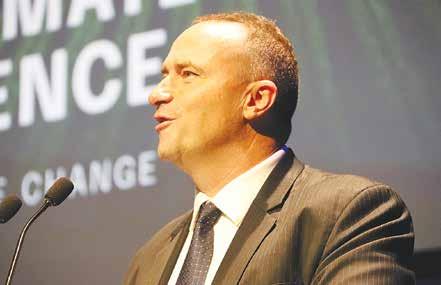
Roche says it’s pretty clear that major global food companies are looking for carbon neutrality from the food system. He says agriculture accounts for 90% of the carbon footprint in food systems and that is inside the farm gate.
“We need to start there,” he says.
On the positive side, Roche reckons he’s never met a farmer anywhere in the world who doesn’t
want to do the right thing by climate change.
“Go to any farmers’ conference and you will hear genuine conversations about their willing-





ness to deal with climate change. It’s a case of continuing the conversations and providing solutions and not just criticising, which is unhelpful.”

A CANTERBURY farmer’s plan to establish a 2,200-animal composting barn feedlot, near the environmentally sensitive Te Waihora/Lake Ellesmere, will go to a public hearing.
Farm company Wongan Hills has applied to Environment Canterbury (ECan) for consents to build four large barns on a farm in the Kaituna Valley, where owner Brent Thomas wants to house Wagyu beef for export.
The valley is a steepsided catchment on the south east side of Banks Peninsula draining into the lake, which is only about 3km downstream from the proposed site.
Public notification of consents is only required in rare, specific circumstances. However, an ECan panel decided last December to put it to the public, mainly on the grounds of flood risk. The period for public submissions closed earlier this month and ECan consents planning manager Aurora Grant says
128 submissions were received, of which 28 want to be heard.
“We are still working through these,” he told Rural News. “However, general themes include concerns over the flooding risk, impact on Te Waihora and animal welfare. The majority of the submissions received oppose the application.”
Grant says a hearing, before independent commissioners is likely to be held before June with a decision due within 15 working days thereafter.
Among the most prominent opponents is the local community group Little River Eco Collective. Its submission highlights five main objections. These include
flood risk, and the risk of discharges, odour and dust affecting the highly sensitive environment as well as affecting local residents.
The group also claims the design of the barns is not well tested, while greenhouse gas emissions from the activity are inconsistent with policy and national directives.

Spokesman, University of Canterbury Professor Donald Matheson says the group includes farmers and other rural people and it does not want to come across as anti-farming.
But he believes the development is in a valley where the flood risk is higher than the applicant’s modelling, and only likely to get worse. The group submission claims floods with as severe impact on the site as its 200-year model
predicts “appear to occur every two years”.
It also says the model fails to account for the greater severity of flooding events in the context of climate change, “such as those associated with Cyclone Gabrielle, where 170% of 100-year flood levels was evident in some catchments”.
“If you’re going to do
industrial-scale agriculture – 2,200 cattle in four large barns is quite a big development – it needs to be in the right place,” Matheson told Rural News Thomas did not respond to a request for comment, but a document outlining a revision of the proposal, dated May 2022, describes a
composting system that captures 100% of nitrogen effluent with no need for a liquid effluent system and therefore a reduction in N leaching.
Matheson says the idea of composting barns capturing nitrogen and reducing runoff is “great while it works” but there is a danger of them going anaerobic.
“If these things are not managed really well you have, not just the problem of cattle standing around in a field producing effluent, but you have a really concentrated problem of large amounts of effluent,” he explains.
“The scale of this operation is large. The scale of the risk is really large.”
Thomas says New Zealand can’t compete with cheap beef from Chile and the US and our point of difference is high quality grass fed beef animals raised to high standards.
“We’d argue that New Zealand farming should think very carefully about building more of these beef farm operations that are running 24 hours a day,” he adds. “We’ve had people in the farming sector saying this isn’t the direction we should be going.”
Members of the group have met with Thomas, his farm manager and consultants. But Matheson says they felt he (Thomas) treated it as an opportunity to reiterate his intentions rather than hear their concerns.
“There wasn’t really a conversation there.”
Sale
Stewart & Julia Eden
33 McDonald Road
Balfour Southland
High Quality, High Producing Holstein Friesian Herd & Replacements
Wednesday 12 April 2023, 10.30am On Farm
Hybrid Auction with Bidr in attendance

Comprising –
187 M/A Holstein Friesian Cows
23 R2 Holstein Friesian In-calf Heifers
27 R1 Holstein Friesian Heifers
6 Java South Devon Bulls
Fermoy est. 1990 Represents 33 years of Holstein Friesian breeding history, using the very best of sires from around the world, Cows sell with records to 11,358 litres, 385 kg protein and 506kgs fats, 64 lots are A2/A2. Opportunity to purchase from a tremendous herd which is uniform in type, with nice confirmation, using Semex optimate breeding program for a number of years.
Catalogues with full terms and conditions are available online at agonline.co.nz – upcoming sales and bidr. co.nz


Enquires
PGGW Mike van der Linden 027 609 9187
“We are still working through these. However, general themes include concerns over the flooding risk, impact on Te Waihora and animal welfare. The majority of the submissions received oppose the application.”
Fast growing/high producing stock grazing new pastures, crops or supplementary feed are more vulnerable to clostridial disease and sudden death.1,2


That’s why we created Covexin®10. Made here in New Zealand specifically for our conditions, Covexin 10 offers the most comprehensive clostridial protection available on the market today.




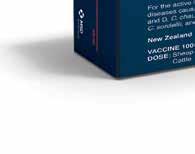
Talk to your vet about upgrading to Covexin 10 and get peace of mind that you are providing the best clostridial protection for your stock.

BEEF+LAMB NZ’S annual meeting will be an interesting affair this year in a number of ways.
The meeting is being held in New Plymouth on March 30 and has garnered a record nine remits from levy payers.
The nine remits range from a demand for B+LNZ to immediately exit He Waka Eka Noa, an independent review of B+LNZ advocacy, change to weighted levy voting, asking for clarity on the role of the Farmer Council and a request for advocacy from the sheep and beef sector in the first instance.
Another key point of interest will be the results of the director election for the southern South Island ward. This has seen current B+LNZ chair Andrew Morrison face a stiff challenge from fellow Southland farmer Geoff Young.
Like many of the remits proposed, the director election contest is seen as a challenge to the B+LNZ status quo and a demand for change.
This would all indicate that there could be blood on the floor at this year’s AGM. However, history has shown a dismal lack of engagement in voting by red meat levypayers in the past – something around the 20-30% mark is the standard – and nothing indicates any change on this front this year.
Farmers only have themselves to blame if they fail to vote and engage in their industry’s democratic process.
It is a bit rich for levypayers to complain about the work of B+LNZ when they can’t even be bothered voting for who they put on the board of the organisation or the remits asking for change.
Undoubtedly there is a feeling of discontent among some farmers about B+LNZ’s advocacy on a number of issues and the remits put up at this year’s AGM are proof of this.
However, the voting results will show if this feeling is widespread among red meat farmers or just fanned by a bunch of malcontents who do not represent the majority.
B+LNZ levypayers need to remember, you get what you vote – or don’t vote – for!
Your canine crusader sees that the fun police have struck again and killed off an iconic rural event. After 20 years of successfully running the iconic Te Kuiti Great NZ Muster – which sees a mob a sheep run through the town to coincide with the NZ Shears and attracts lots of visitors – concerns from the local council about health & safety has led it to can the event. Waitomo District Council has ruled it can no longer hold the event, citing ‘health & safety’ concerns. Mayor
John Robertson claimed this was a “shame” but “controlling the sheep has been an issue in the past and that “times have changed” and council had “reluctantly” opted to close the event for good. This is despite the fact that the council has conceded not having the event “would be a loss that attracted an array of visitors to Te Kuiti”.
The Hound was astounded at the glib response from Greens leader James Shaw to a written parliamentary question from ACT MP Mark Cameron. Shaw was asked if he was surprised that farmer confidence was at a record low in the latest Farm Confidence Survey and if he believed one of the top concerns of farmer respondents was “regulation and compliance costs – a catch-all for the wave of reform, regulation, red tape and costs swamping the sector?” Shaw replied: “The agriculture sector contributes 50% of New Zealand’s gross emissions. Approximately 94 % of our nitrous oxide emissions and around 91% of our biogenic methane emissions are from agriculture.” Cameron actually thought Shaw’s office had mistakenly submitted the wrong answer, but they clarified it is exactly what the Climate Change Minister intended to say.
PRODUCTION: Dave Ferguson Ph 027 272 5372 davef@ruralnews.co.nz
Becky Williams Ph 021 100 4381 beckyw@ruralnews.co.nz
Your old mate notes that regulations governing NZ’s pig sector could end up seeing us running out of locally produced pork – like we are currently experiencing with eggs. Pork NZ reports that more than 50,000 metric tonnes of overseas pork was imported into New Zealand during 2022, most of it from countries that allow pig farming practices that are illegal in New Zealand. According to Pork NZ, almost two thirds of the pork consumed in NZ comes from overseas, but there is no requirement for it to meet our animal welfare standards. Around 98% of the pork imported from overseas comes from countries that use sow crates, which are banned in NZ. Our pork sector has more stringent welfare and environmental standards compared to other countries. This sounds like a recipe for disaster for the NZ pig farming sector.
AUCKLAND SALES REPRESENTATIVE: Stephen Pollard Ph 021 963 166 stephenp@ruralnews.co.nz
This old mutt reckons both government and officials are failing to see the wood for the trees in regard to the huge swathes of good farmland going into forestry – much of this to overseasowned carbon sinks. According to Newshub, from information revealed under the Official Information Act, 25 times more land was converted into forestry last year than a decade ago. It shows a rise in new forestry area from 695ha in 2013 to more than 18,000ha last year. Beef+Lamb NZ says it is alarmed by this figure and while it is not against off-setting via commercial forestry, it argues that there needs to be some limits put on it. Your old mate hopes the Government’s ‘ministerial inquiry’ into forestry slash will lead to limits on land conversion, as it needs to answer for its policies incentivising forestry to earn carbon credits.
WELLINGTON SALES REPRESENTATIVE: Ron Mackay Ph 021 453 914 ronm@ruralnews.co.nz
HEAD OFFICE POSTAL ADDRESS: PO Box 331100, Takapuna, Auckland 0740 Phone 09-307 0399

PUBLISHER: Brian Hight Ph 09 307 0399
GENERAL MANAGER: Adam Fricker Ph 021-842 226
CONSULTING EDITOR: David Anderson Ph 09 307 0399 davida@ruralnews.co.nz
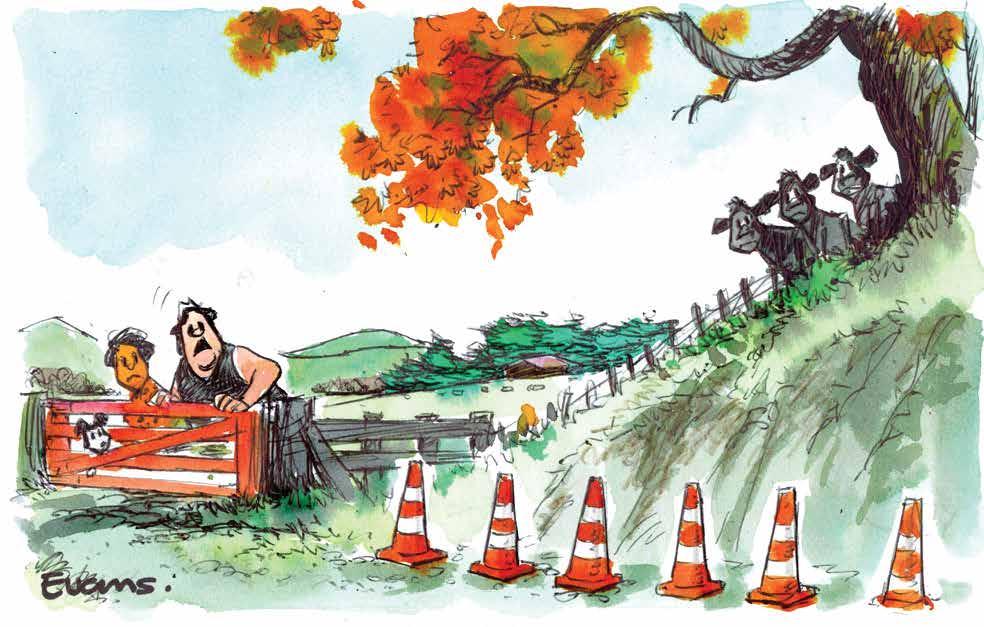
REPORTERS: Sudesh Kissun Ph 021 963 177 sudeshk@ruralnews.co.nz


Peter Burke Ph 021 224 2184 peterb@ruralnews.co.nz
MACHINERY EDITOR: Mark Daniel Ph 021 906 723 markd@ruralnews.co.nz
WAIKATO SALES REPRESENTATIVE: Lisa Wise Ph 027 369 9218 lisaw@ruralnews.co.nz
PRINTED BY INKWISE DISTRIBUTED BY REACHMEDIA
SOUTH ISLAND SALES REPRESENTATIVE: Kaye Sutherland Ph 021 221 1994 kayes@ruralnews.co.nz
DIGITAL STRATEGIST: Jessica Marshall Ph 021 0232 6446
“We’re being invaded!”
THE GREAT pics and stories continue as, of course, does the huge cleanup!
I can recommend the video clip farm suppliers Te Pari produced. If you haven’t seen it, it should come up for you if you Google ‘Te Pari Cyclone Video’.

The very best in people has come to light through all this. Total strangers turning up with shovels and wheelbarrows, putting in untold hours of the toil, helping people they had never previously met. We had a group of skilled guys from our area head across to the Hawke’s Bay for several days to assist, mainly with shearing and fencing repairs, I believe.
Aside from all the hands-on stuff, donations, mostly anonymous, have poured in from all over this great country
of ours. Even the key farm-staff members, the working dogs, have not been forgotten, with dog tucker included with the donated support!
Yes, if for one reason or another you were not able to physically get to where help was needed, you could always donate. And many, as we did, have done exactly that.
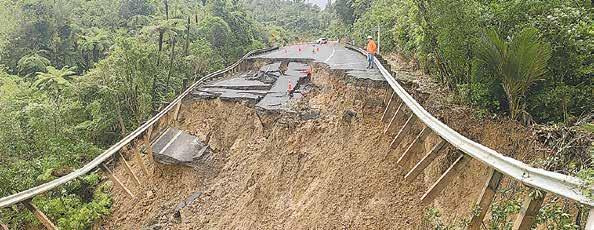
Sadly, I have to say, some of the worst stuff has also came to light.
I’m thinking especially of the looting. How selfish,
but also how sad! But there’s more, I think.
I was brought up with the old adage; “Always give credit where credit is due.” So, I try my best to live that. I think I have got much better at it too, as the years and life’s experiences have accumulated for me!
It was brought to my attention by a couple of people, that Bishop Tamaki had a large number of their people,

along with their “ManUp” guys, putting in a huge shift. But so far –though I have been keeping an eye out – I have not seen any mention of this in the mainstream media!

Also, it truly is a shame when people attempt to politicise tragedies like Gabrielle, and score perceived political points for themselves, from others’ adversities.
Wouldn’t it be refresh-
ing if some actually managed to jerk themselves up out of the gutter and take the ‘high road’ for a change?
Yep, there are lots of great stories, which of course will continue to come out as the massive cleanup continues. For those of you who have pretty much lost everything, our thoughts and prayers are with you.
Now, in an attempt to brighten up your day
in some small way, I thought I would sign off by including a little something from my files that I have always found amusing and rather enjoyed. If you have little children, or grandies, you should enjoy these… might even find them cute!
I’m sure we had the book many years ago titled Children’s Letters to God.
The letters were all in the kids’ own handwriting
too, which I can’t repeat here sorry. Anyways, here’s a sample:
“Dear God, I bet it is very hard for you to love all of everybody in the whole world. There are only 4 people in our family and I can never do it.”
“Dear God, Maybe Cain and Abel would not kill each so much if they had their own rooms. It works with my brother.”
“Dear God, I went to this wedding and they kissed right in church. Is that OK?”
“Dear God, Thank you for the baby brother but what I prayed for was a puppy.”
Well, that’s it from me this month. I trust the aid and support you may need is reaching you. Remember, it’s ok to ask if you need help. Keep well and God bless.
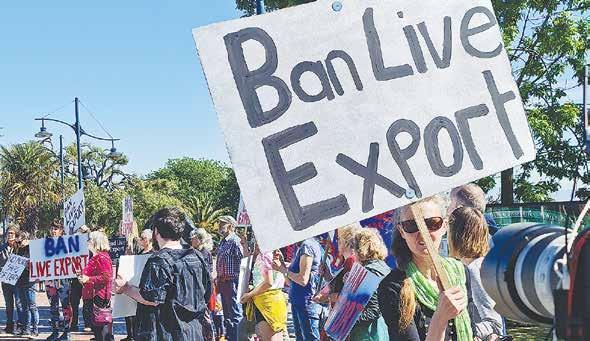
try recovers.
FEDERATED FARMERS
is pleased that a Member’s Bill from ACT MP Mark Cameron has put opportunities for live animal exports back on the political agenda.
With industry-initiated Live Export NZ ‘Gold Standard’ animal welfare precautions – as well as enforcement of the recommendations on sea voyages from the independent review – New Zealand can be a global exemplar in this trade.
Recent cyclones have put a massive hit on our infrastructure and productive sector. For example, it may be years before our pipfruit indus-
Can New Zealand afford to turn its back on annual export income of $400m-$500m?
The government-instituted live export ban comes into full effect on 30 April this year after a transition/wind-down period.
New Zealand has an international reputation for strong animal welfare. While there has been robust and continuous improvement in our live export practices, the industry is open to recommendations for further protections. These include regulation aimed at minimising sea voyage risk from seasonal weather events.
The global live cattle trade will continue but from countries and by exporters with lower
animal standards filling the gap enforced on us. If we were still involved, our high standards would
push others into lifting their game.
We’ve also lost the opportunity to have influ-
ence, via commercial relationships, over the welfare of exported animals after they’ve arrived
in countries such as China.
Federated Farmers and the many businesses, which have been involved in this trade, want discussions re-opened.
But the debate should be based on facts rather than politics and ideology.
It’s an election year, and rural New Zealand looks forward to hearing the policies of the various parties on this topic and others that are so important to provincial economies.


• Richard McIntyre is a Federated Farmers national board member and its Dairy Chair.
@rural_news facebook.com/ruralnews
CHINA’S REOPENING

and changes in Chinese consumer behaviour is expected to provide business opportunities for beef exporters but also generate volatility in global markets.

That’s according to Rabobank’s newly released Q1 Global Beef Quarterly, which says it expects overall Chinese household consumption will rebound strongly in 2023 from the low base of 2022.
Despite marginal growth in food and beverage retail and the impact of ongoing Covid restrictions on food services, there are positive signs of recovery.
Rabobank agricultural analyst Genevieve Steven says they’re seeing changes in the recent behaviour of Chinese consumers, who are becoming more pragmatic in spending money on products they perceive to be practical, valuable and worthy. However, she says weaker economic conditions will have some impact on Chinese beef consumption among lower-income groups.
“But to other consumer groups – mainly younger generations, middle to high income families and health-conscious people – beef is perceived to bring better taste, more health benefits and different eating experiences compared with traditional meats.
“We see beef trad-
ing both up and down as consumer groups become more segmented. Although total consumption may increase more slowly, we expect a gradual [overall] increase.”
Steven adds that evolving market channels and consumer behaviour are also influencing the development of China’s beef market. With food service previously the main channel for beef consumption, retail chan-
nels are now seeing rising sales.
Despite a slow-down in beef imports in the first half of the year due to pre-existing high inventory of frozen beef, consumption in China is still predicted to steadily expand in the coming years.
An atypical form of BSE recently being identified in Brazil leading to self-imposed export suspensions to China is also



expected to impact beef trade. Rabobank says whether New Zealand sees any benefit for beef demand and returns will be determined by how long the suspension lasts.

Meanwhile, the report says New Zealand beef production declined 4% in 2022, which Steven attributes to reduced beef cow processing.
“Whilst volumes to the US and overall volumes declined, export earnings rose 20% YOY and exports to China and Japan both grew 5%.”
Weaker demand from China and lower average market returns reinforced by the strengthening of the NZD/USD led to a plunge in farmgate prices in Q4 2022.
Returns settled through early 2023 and
RaboResearch anticipates the Q1 North Island bull price will remain elevated above the five-year average price.

Steven said the livestock losses, infrastructure damage and flow-on effects because of Cyclone Gabrielle will become more apparent through March. She adds that damage to road infrastructure will impact the ability to get staff and livestock to processing plants in the coming weeks or months.
“With significant infrastructure damage, some may need to offload animals. Good feed levels across most of the country should support the store market.”

This rear discharge spreader provides precision manure spreading management. Unique technology of the shredding rotor and spinning discs provides a precise application of manure.

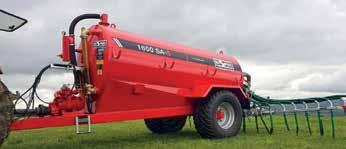

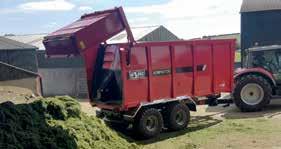
“We see beef trading both up and down as consumer groups become more segmented. Although total consumption may increase more slowly, we expect a gradual [overall] increase.”

MOST IRISH farmers are pretty much on board with the need to reduce their agricultural greenhouse gas emissions.
That’s the view of one of Ireland’s leading scientists in this field, Professor Tommy Boland from the University College of Dublin (UCD). He was one of just two international keynote speakers at the recent climate change conference in Wellington.
Boland has been a regular visitor to NZ over many years and is involved in collaborations with scientists in NZ and especially at Massey University.
The reason for this is the huge amount of similarity between Ireland and NZ in terms of the agri sectors to their respective economies. Both nations run similar pasture based systems to produce dairy products and meat for export.
The Irish government has set a
target of a 25% reduction in agricultural greenhouse gas emissions by 2030, based on a 2018 starting point. Boland says Irish farmers, like their counterparts in NZ, are looking for solutions and information on how they can achieve this target.
“They are hungry for knowledge, so as someone who works in the research sector, we have a big responsibility to generate that information and knowledge.
“There has to be a sector, not just a farmer, approach to deliver those solutions on farm and to support the farmers in the uptake and implementation of those solutions,” he says.
Boland says at the moment there are a number of different technologies available such as breeding techniques, new fertilisers and fertiliser use.






He says it’s predicted that if there is widespread adoption of these techniques and some others, they will deliver about one third of the emis-
sion savings needed to achieve the 2030 target.
Boland says the funding approach to dealing with GHGs is similar in both Ireland and NZ, although the mechanism is slightly different in his country. There, the Ministry of Agriculture
Food and Marine (similar to our MPI), is the main research funder, along with their Environmental Protection Agency (EPA). He says in Ireland there has been a significant investment into GHG research with emphasis on core technologies and building up expertise
within the science fraternity.
Collaboration in respect of GHG research between Ireland and NZ has been going on for a long time. Boland says there are some very strong personal relationships built up between Irish and NZ scientists. In parallel to this, there are many formal funding agreements, all of which have added to the richness of the knowledge on the subject.
“These include bilateral agreements between our Ministry of Agriculture and MPI,” he says.
Boland says this collaboration is likely to increase, especially with the signing of the FTA between NZ and the EU, which will give NZ access to EU research money. He also adds that there is strong collaboration between Ireland and NZ in the agritech space. “There is always more that can be done, but I think we are in quite good space in terms of collaboration between the two countries.”
ALMOST $130,000 has been raised for charity during a marathon 24-hour shearing event for rural communities, many of whom are now struggling even more after Cyclone Gabrielle.


‘Shear 4 U’ took place over the weekend of January 21 and 22 at Pukemiro Station, near Dannevirke. The primary aim was raising awareness and generating support for rural health and wellbeing.
Farmers Isaac Scott, Adam Roe, Vaughan Wrenn and Dan Billing formed the core of the event, with a fifth stand made up of supporters and novelty shearers.
None of the shearers were professionals – just ordinary farmers – but what they achieved was truly extraordinary.
In terms of sheep shorn, the goal was 6000 over the 24 hours, but shearers managed to get through a whopping 6654.
That’s one sheep being caught, dragged and shorn every 66 seconds, plus the time spent eating, drinking and maintaining handpieces to keep them running well.

As the event went on, around 500 people came along to watch during the stint, with peak attendance of 300 people filling the entire shed.
Dan Billing, who farms near Dannevirke as well as working as a senior agri relationship manager for ANZ, said the event was both “humbling, and
epic all at the same time”.
“Humbling in the sense that I had no idea of the impact that it had on the community, and how this translated to support that we received,” he said. “And epic in that this was a once in a lifetime experience; something that I’ll remember forever.”
Billings admits there were several really challenging moments during the 24-hours that he had to work through.
“In the second and third runs, I cut myself reasonably bad,” he explains “I had to get my head into a space where I wasn’t thinking about the pain, or how it was limiting me in what I was doing.”
Another challenge was from 5am to 7am on the Sunday, when he had to deal with severe stomach cramps.
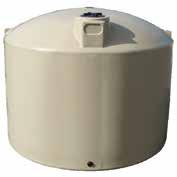
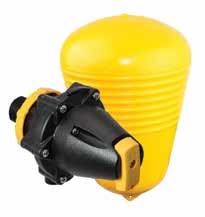
“The other difficult part was completing the last two hours,” Billings adds. “Prior to then,
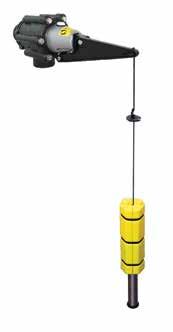
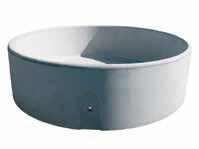


there was always something to keep working for. But at that point, I knew it was the end, which meant I had to focus on smaller parts of the last two hours to keep focus.
Billings said he changed his mind-set: instead of thinking of two hours to go, it became 30 minutes shearing 25 sheep.
“Then it was down to five minute blocks, then
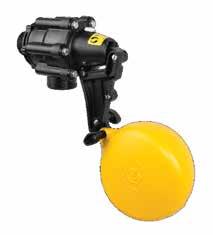
sheep-by-sheep, right through to the last five minutes – then it was easy to see it through, with the support team around me.”
The money raised ($128,594.36) will be divided between three charities – Hear4U, the Breast Cancer Foundation, and the Rural Support Trust.
Billings says knowing the funds raised during
the event will be desperately needed following Cyclone Gabrielle “makes us appreciate the event, and the support we got even more”.
“The funds raised for RST and Hear4U will be used in a way that can only do good. We are humbled that what we did will have some tangible benefits to those affected,” he says.
“Now more than
ever, we as a community, as friends, as family are here to help and support those that need it. Having the help of those that care will help to get you through these tough times.”
Hear4U director Krissy Mackintosh says the event was unbelievable. “We watched in admiration as four men advocated for our charity, with such determination, concentration, and hard mahi,” she says.
changes.
“The efforts of Team Shear4U, demonstrated ‘rising above’ hard times, through unity, and good old fashion community love.”
Breast Cancer Foundation chief executive AhLeen Rayner says it was an honour to be a recipient from this fundraiser.
“We’re blown away by Dan, Vaughn, Adam and Isaac’s heroic efforts, which were all the more special given their personal connections to the causes they’ve supported,” she says.
“Their donation will help us to provide practical support to breast cancer patients and fund scientific research to find better treatments and save lives.”
Rural Support Trust Area coordinator for Tararua Jane Tylee also attended the event, and praised the work that went into making it happen behind the scenes.
“The shearing shed was a perfect place to break the stigma around mental health, and our team spent the entire day connecting with rural families affected by mental health challenges, or suicide.”
Mackintosh says rural communities have had an extremely tough year due to political, environmental, and systematic
“It really was a phenomenal effort, and we feel really privileged to be a recipient,” she explains. “We really depend on funding and sponsorship like this to be able to keep doing what we do –providing support during tough times to our rural communities.”
Meanwhile, in the wake of Cyclone Gabrielle, ANZ is donating $3 million to affected communities, including $1 million specifically for agriculture and horticulture groups.
BEEF+LAMB NEW Zealand (B+LNZ) is reminding farmers to protect themselves, their families and stock as cases of Salmonella and Leptospirosis rise in the wake of Cyclone Gabrielle.
“Salmonella and Leptospirosis are already rearing their heads on the East Coast of the North Island following Cyclone Gabrielle,” says B+LNZ’s senior advisor for biosecurity and animal welfare Will Halliday.

Leptospirosis lives in water and spikes of the disease are often seen after flood events, while bad weather can also increase the spread of Salmonella. Leptospirosis can infect all mammals and sits in the kidneys and genital tract of infected animals.
People who come into
contact with an infected animal’s urine are most at risk of contracting the disease, but the bacteria can also live in soil and water contaminated with animal urine.
Healthy, well-grown animals are more likely to spread Leptospirosis to people through their urine, posing a risk during milking, calving, lambing, shearing, as well as slaughtering and processing stock.
“All mammals can be infected by Leptospirosis and we’re currently seeing an increased number of cases in dogs,” says Halliday.
“It can enter the body through scrapes and wounds and through the mucous membranes, so it’s important for farmers to protect themselves from animal urine by wearing protective clothing, covering wounds, and washing
thoroughly after handling animals.”
He adds that freestanding water or puddles can be a source of Leptospirosis on farms.
“This can include puddles around water troughs where animals may have urinated.”
The symptoms of Leptospirosis include headaches, flu-like symptoms and muscle and gut pain, but can present in a number of ways.
Meanwhile, Halliday says cases of Salmonella are also on the rise.
“The best form of prevention of Salmonella and Leptospirosis is for farmers to vaccinate their animals to stop people getting sick, prevent infections and reduce stock loss,” he explains.
“Vet clinics in the region are up running, so farmers shouldn’t hesitate to organise vaccinations.”


Cropping farmer Andrew West’s property is located east of Ashburton in the typical coastal district of Wakanui, where temperatures average 16 degrees and the annual rainfall is 264mm. The cropping program has a relatively intensive rotation including specialty crops buckwheat and hemp. Andrew recalls that around 8 years ago he felt like they were hitting a wall yield wise and this stimulated them to start looking outside the square about what was missing.

Their extensive self-reflection and analysisled them to 3 key findings:

Once realising that they were in a system that was merely feeding their crops rather than building their soil nutrient status they began to investigate the role different nutrients play in the profile. The importance of both magnesium and calcium in maintaining healthy soils became evident. Once they understood the role of these two nutrients a natural link to Golden Bay Dolomite was made with its composition of magnesium and calcium.
Based on their production findings, Andrew believes that Golden Bay Dolomite is an essential ingredient to any nutrient program. As a natural product, Golden Bay Dolomite is one of the best sources available in the world of magnesium and calcium and is easier on soils than synthetic forms. The benefits of both magnesium and calcium are that they provide a foundation for the uptake of other key nutrients (NPKS) needed for plant growth. Calcium in particular acts as a catalyst for the translocation of other nutrients increasing their plant availability.
JOHN DEERE has announced the latest updates for its 2024 lineup of 7, 8 and 9 Series tractors.

These are said to be a leap forward in precision technology and acceleration towards an autonomous future. The updates include the StarFire™ 7000 integrated GPS receiver and G5Plus CommandCenter™ Display, which will be factory-installed across the entire product range. In addition to including the new receiver and display as base equipment, optional automation features like automated headland turns allow farmers to reach a level of operation on the doorstep of autonomy.
John Deere productions system manager Ben Kelly says the updates offer farmers immediate and powerful precision ag capabilities, while providing the foundation for autonomous capabilities in the future.

“Improving signal stability and reliability has also been a major focus in the development of these new tractors and will provide farmers with the highest level of guidance and accuracy ever offered by John Deere.”
The new SF7000 Receiver uses a new
signal level, SF-RTK, to provide growers with +/2.5 cm accuracy direct from satellite with five years repeatability. This
offers almost an equivalent to traditional Radio RTK accuracy, without the inconvenience of managing base stations

on farm. It also presents a pull-in time of eight minutes, which is a significant upgrade compared with the SF3-signal-

enabled StarFire 6000 receiver’s +/- 3 cm accu racy and 20 minutes pullin time.
that due to tectonic plate movement and proximity to a tectonic plate bound ary, SF-RTK may not be repeatable in New Zea land.
the tractors and implements is also addressed with a factory-installed implement ethernet connection, enabling future high-bandwidth communication between tractors and implements.

Meanwhile, operator comfort and ease-ofuse has been addressed to increase visibility and safety with the new righthand corner post display added inside the cab of MY24 7 to 9 series tractors.
A factory-installed rear-window tint is also available for CommandView™4 cabs, to help keep operators comfortable while providing better visibility to display
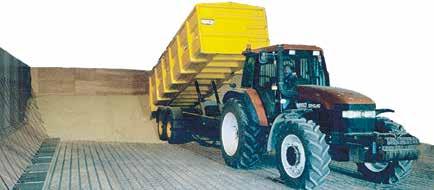
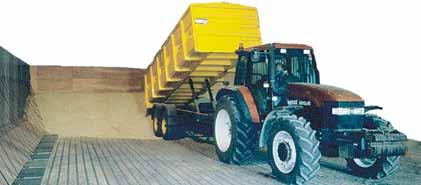

CommandCenter Dis play (and optional G5Plus Extended Monitor) fea tures increased process ing power and faster file transfer times compared to previous displays. G5Plus, 12.8-inch touch screen, also offers a 35%
• Augers, conveyors, grain vacs.
• Hopper and flat bottom silos, unloaders, full drying silos c/w stirrers.
include an extra 20hp for -
• Augers, conveyors, grain vacs.


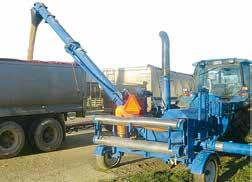


• OPI grain management systems European dimensions info
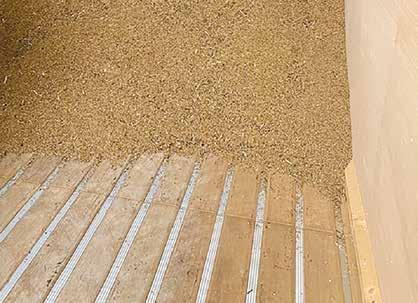
• Hopper and flat bottom silos, unloaders, full drying silos c/w stirrers.
are compatible with 16.5,
• OPI



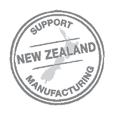
AARON BETT, current managing director for CNH Industrial Capital Australia/New Zealand, will take over the position of general manager, Case IH Australia/New Zealand, effective April 4.
This follows the recent departure of long-term incumbent Pete McCann.
Bett joined CNH Industrial, Case IH’s parent company, around six-and-a-half years ago. For the last three years, he has led CNH Industrial Capital ANZ, a business that has supported Australian farmers for more than 40 years and launched into the New Zealand market in 2021.
“Aaron had been around agriculture all his
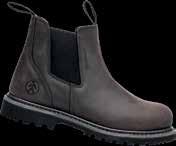
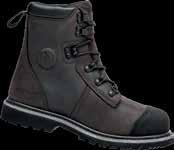
life and had the expertise, experience and vision to lead Case IH into an exciting future,” says Brandon Stannett, CNH Industrial managing director, Australia/New Zealand.
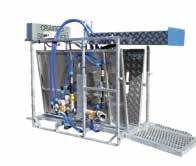

Case IH dealer network.”

“Aaron understands the industry and has a real passion for agriculture and the machinery and technology that powers it. He also understands the needs and expectations of our customers and has established close working relationships with the

Bett says it was an exciting opportunity and a chance for a new challenge, and he looks forward to working with the Case IH team on key priorities, new ideas and long-term strategies for the ongoing growth and evolution of the brand.
“I am passionate about the industry and where it’s going, and the Case IH brand, which we’ve used on my family property for more than 40 years,” he adds.
“I know how important machinery is to farmers and how much they rely on it for their


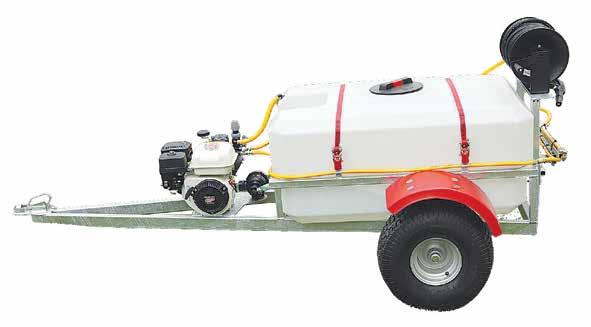
livelihoods.
“Up-time, reliability, servicing and parts availability, are critical to ensuring machines are operational when they’re needed most and that will remain the priority for me and my team.”
Bett says he looks forward to bringing some
new ideas to the table and working with dealers and our customers on further strengthening the key pillars of the brand.
“Ensuring Case IH continues to deliver the innovation, consultation, efficiency and productivity for which it’s renowned.”
“I am passionate about the industry and where it’s going, and the Case IH brand, which we’ve used on my family
for more than 40 years.”












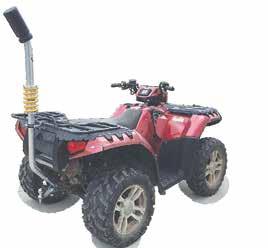


Rarotonga Relaxer - 17 May*
8 days tropical Cook Islands, beachfront Vivid Sydney - 25 May
5 days Vivid Festival ,Tina The Musical Sunshine Coast - 13 Jun*

8 day Winter Sun, Coast & Mountains
Cairns & Port Douglas - 6 Aug
12 days Barrier Reef, Fitzroy Island
Canada & Alaska - 13 Sep

21 days Rocky Mountaineer & Cruise
Southern Africa - 17 Sep

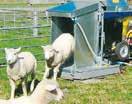



20 days Wildlife, Victoria Falls, Botswana

Perth Wildflowers - 12 Oct
11 days Spectacular Wildflower Festival
Tasmania Spring - 2 Nov
11 days Wild Beauty of Tasmania





